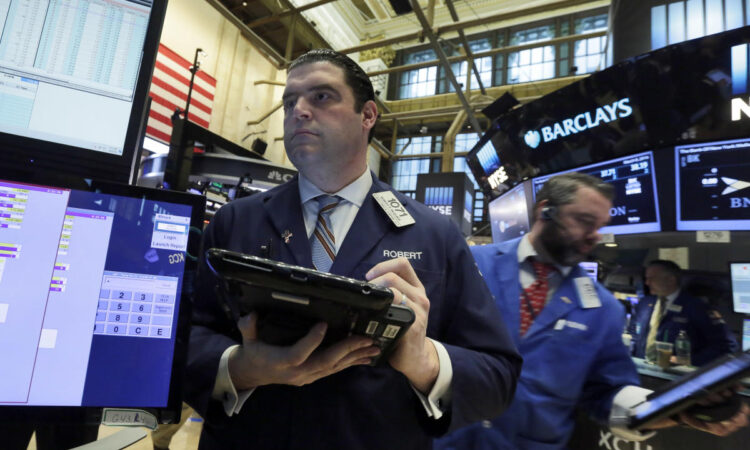
A verson of this article was published on TKer.co.
Stocks fell to kick off 2024, with the S&P 500 shedding 1.5% to close the week at 4,697.24. The index is now up 31.3% from its October 12, 2022 closing low of 3,577.03 and down 2% from its January 3, 2022 record closing high of 4,796.56.
Nothing triggers investor anxiety like a weak week for stocks.
“Rollercoaster rides are unnerving on the way up and then thrilling on the way down,” veteran Wall Street strategist Ed Yardeni wrote on Thursday. “Stock markets are thrilling on the way up and unnerving on the way down.”
After an impressive streak of gains — like the nine consecutive weeks of positive returns we had to end 2023 — a negative week can be a valuable reminder that while stocks usually go up, they don’t always go up.
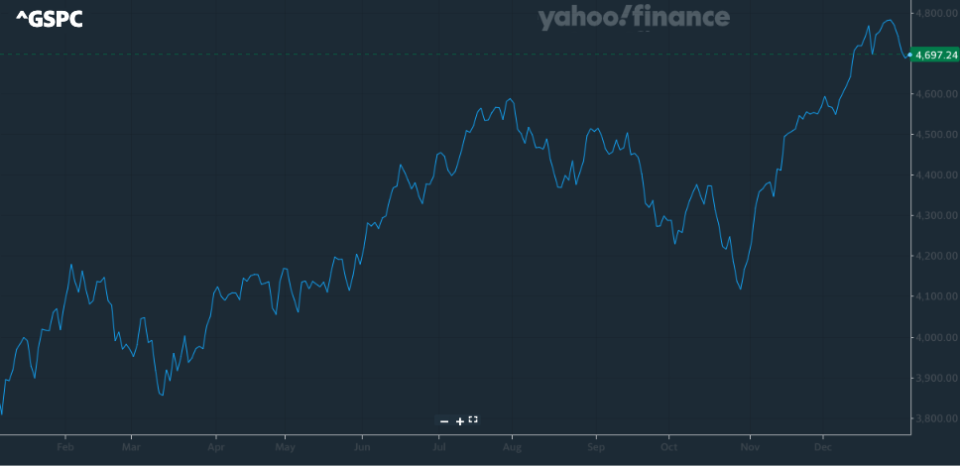

Let’s review some market history.
The chart below from Carson Group’s Ryan Detrick shows that in an average year, the S&P sees at least seven separate dips of at least 3%, three separate pullbacks of at least 5%, and one correction of at least 10%.
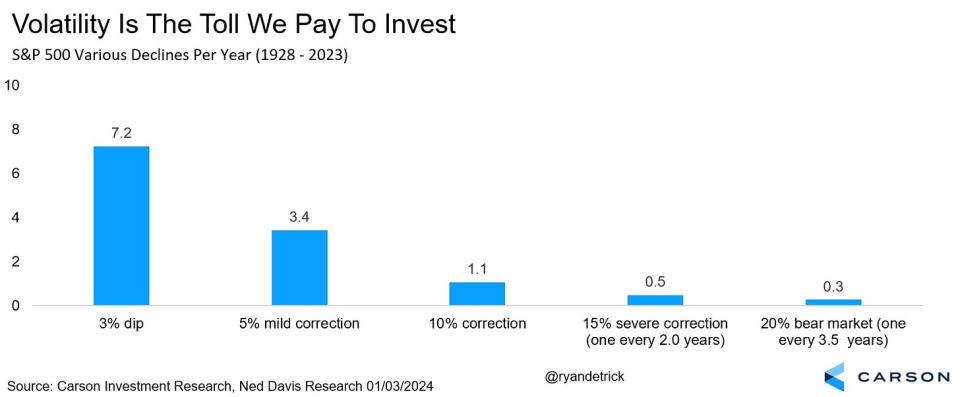

“Volatility is the toll we pay to invest,” Detrick said. Indeed.
In the moment, a big intra-year selloff can be understandably unsettling. But they happen all the time.
Check out the chart from JPMorgan’s Guide To The Markets, which is my favorite visualization of short-term stock market performance.
Going back to 1980, the chart shows each year’s annual return for the S&P 500 in gray and its intra-year max drawdown (i.e., the biggest sell-off from its high of the year) in red. During this period, the S&P has seen an average annual max drawdown of 14% while ending positive in 33 of the 44 years measured. This means that in most years, the market has more than recovered the losses experienced in the max drawdown.
The bottom line: Stomach-churning sell-offs are normal.
‘Good years tend to follow great years’
Considering 2023’s above-average 24% surge in the S&P 500, it may be tempting to think “we’re due” for a bad year.
Sure, there have been a number of instances when bad years followed unusually strong years. Ritholtz Wealth Management’s Ben Carlson reviewed the history and found 16 instances when a year with double-digit gain was followed by a negative year.
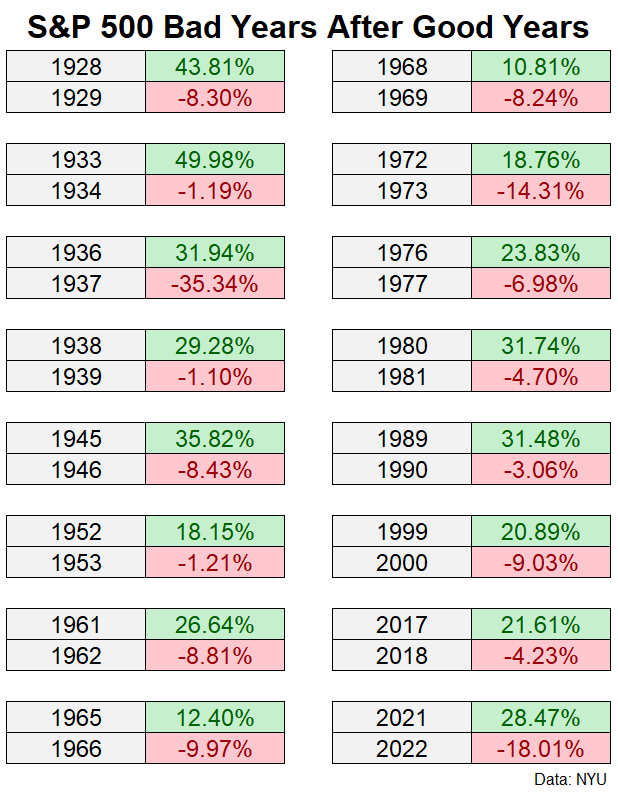

At the same time, Carlson found that it’s far more common for double-digit gains to be followed by further gains.
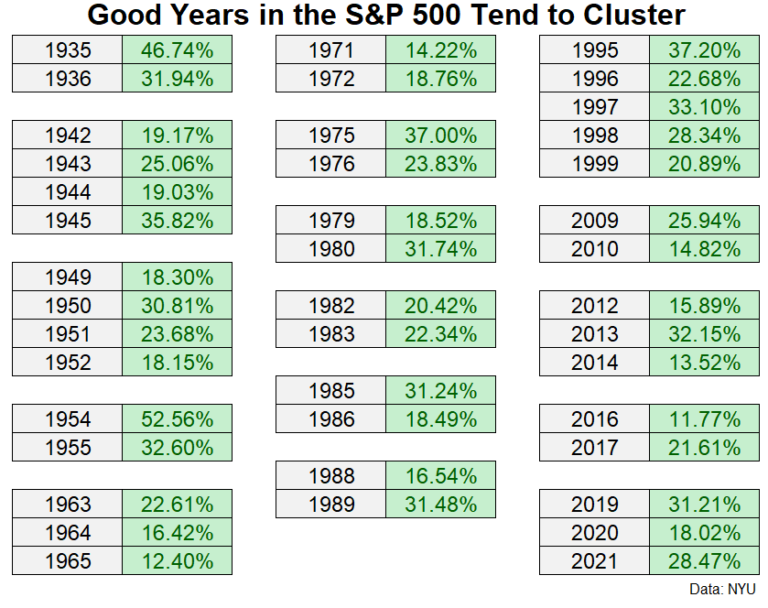

So while we shouldn’t be too surprised if we get a weak year, history suggests we’re more likely to get positive returns.
“Since 1946, the S&P 500 has posted a positive annual price return 71% of the time,” CFRA’s Sam Stovall observed on Tuesday. “Each of these positive performances was then followed by an average increase of 6.9% and a 69% frequency of gain. However, after an annual surge of 20% or more, the S&P 500 rose an average 10.0% in the subsequent year and advanced 80% of the time, showing that good years tend to follow great years with an above-average return and frequency of gain.”
Sometimes we’ll get news that materially changes the big stories driving the fundamental outlook for the stock market. But more often than not, volatility-triggering news represents noise, not a major inflection point.
Zooming out
It continues to be the case that the stock market usually goes up. But it will also continue to be true that it won’t always go up.
So I think it can be helpful to keep stats like the ones above in mind.
While it’s fine to enjoy the many rallies, it’s good to stay grounded so that you don’t get swept up in so much exuberance that you start forming unreasonable expectations for the market. The last thing you want to do is panic at the first sign of volatility when history says volatility is normal.
Reviewing the macro crosscurrents
There were a few notable data points and macroeconomic developments from last week to consider:
The labor market continues to add jobs. According to the BLS’s Employment Situation report released Friday, U.S. employers added 216,000 jobs in December. While the pace of job growth has generally been cooler, a 36th straight month of gains reaffirms an economy with robust demand for labor.


Employers added a whopping 2.7 million jobs in 2023. Total payroll employment is at a record 157.2 million jobs.


The unemployment rate — that is, the number of workers who identify as unemployed as a percentage of the civilian labor force — stood at 3.7% during the month. While it’s above its cycle low of 3.4%, it continues to hover near 50-year lows.
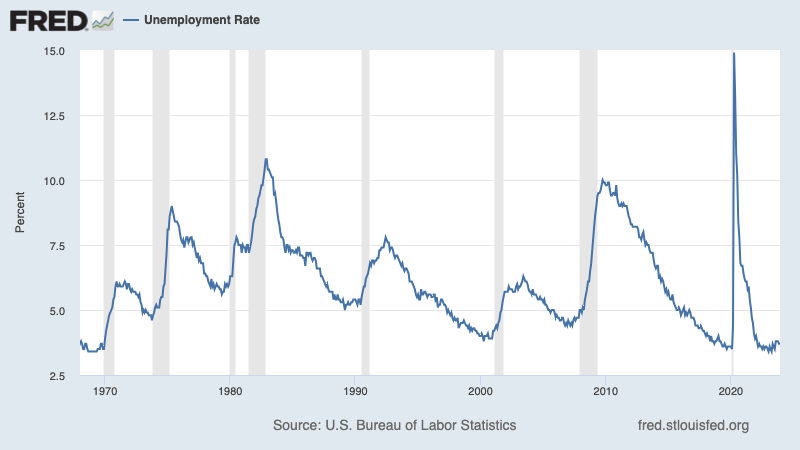

Wage growth is cooling. Average hourly earnings rose by 0.44% month-over-month in December, up slightly from the 0.35% pace in November. On a year-over-year basis, this metric is up 4.1%, a rate that’s been cooling but remains elevated.


Job switchers still get better pay. According to ADP, which tracks private payrolls and employs a different methodology than the BLS, annual pay growth in December for people who changed jobs was up 8% from a year ago. For those who stayed at their job, pay growth was 5.4%.


Job openings tick down. According to the BLS’s Job Openings and Labor Turnover Survey, employers had 8.79 million job openings in November. While this remains elevated above prepandemic levels, it’s down from the March 2022 high of 12.03 million.
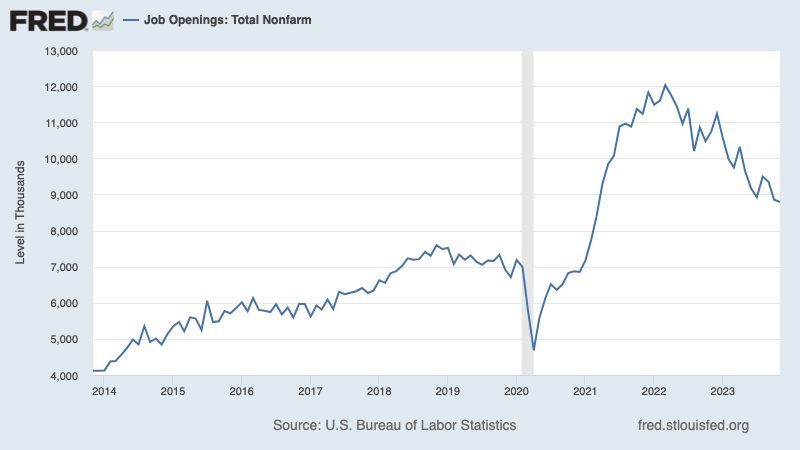

During the period, there were 6.29 million unemployed people — meaning there were 1.4 job openings per unemployed person. This continues to be one of the most obvious signs of excess demand for labor.


Layoffs remain depressed, hiring remains firm. Employers laid off 1.53 million people in November. While challenging for all those affected, this figure represents just 1.0% of total employment. This metric continues to trend below pre-pandemic levels.
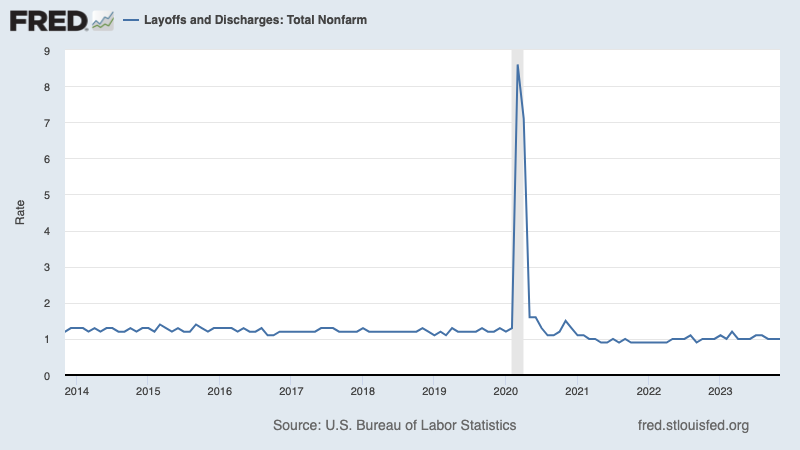

Hiring activity continues to be much higher than layoff activity. During the month, employers hired 5.47 million people.


Unemployment claims fall. Initial claims for unemployment benefits fell to 202,000 during the week ending December 30, down from 220,000 the week prior. While this is up from a September 2022 low of 182,000, it continues to trend at levels associated with economic growth.


Corporations are speaking less about labor shortages. From Bloomberg’s Michael McDonough: “Labor shortages seem to be receding into the rearview mirror, as evidenced by related mentions on S&P 500 earnings calls. Meanwhile, conversations around job cuts are still prominent, though they haven’t reached the heights observed last spring.“
Consumers have been earning interest. From WSJ’s Gunjan Banerji: Americans generated ~$300 billion in interest income from money-market funds in 2023, according to estimates from Crane Data.“
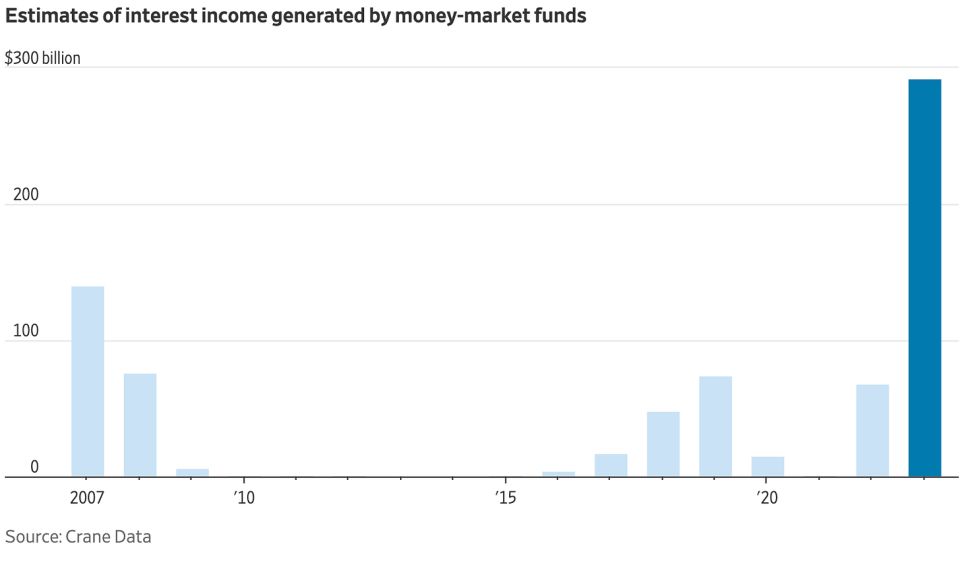

Card data suggest consumer spending is holding up. From BofA: “Total card spending per HH was up 1.0% y/y in the week ending Dec 30, according to BAC aggregated credit and debit card data. Spending on holiday items fell 1.3% y/y in the week ending Dec 30. … However, in the five weeks since Thanksgiving, spending on holiday items was up 0.3% compared to the same period last year.”
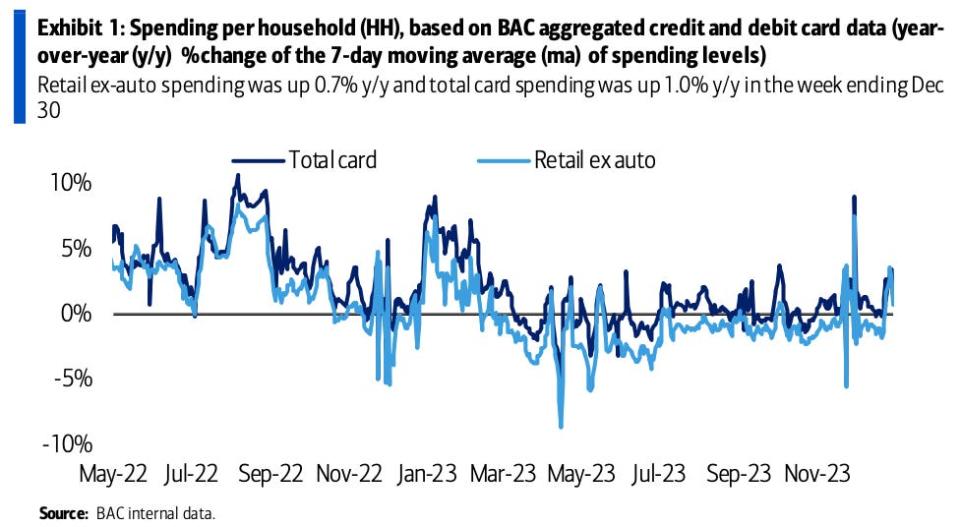

Vehicle sales rise. From Wards Auto via Calculated Risk: “December U.S. Light-Vehicle Sales Hit 5-Month High; Entire 2023 Totals 4-Year Best 15.5 Million… Labor-related plant shutdowns in the U.S. that covered the latter half of September and most of October negatively impacted deliveries in November. Combined sales of the vehicles impacted by shutdowns fell 15% year-over-year in November. If those vehicles had matched year-ago results, sales would have totaled a 15.9 million-unit SAAR.”


Gas prices continue to fall. From AAA: “The national average for a gallon of gas dipped slightly by three cents since last week to $3.09. One reason could be lower demand, as fewer people are fueling up after the peak of holiday road travel… According to new data from the Energy Information Administration (EIA), gas demand nosedived from 9.17 to 7.95 million b/d last week. Meanwhile, total domestic gasoline stocks increased substantially by 10.9 million bbl to 237 million bbl. Weak gas demand, alongside increased supply, has pushed pump prices lower. However, rising oil prices have limited price decreases.”


Mortgage rates tick up. According to Freddie Mac, the average 30-year fixed-rate mortgage rose to 6.62% from 6.61% the week prior. From Freddie Mac: “Between late October and mid-December, the 30-year fixed-rate mortgage plummeted more than a percentage point. However, since then rates have moved sideways as the market digests incoming economic data. Given the expectation of rate cuts this year from the Federal Reserve, as well as receding inflationary pressures, mortgage rates will likely continue to drift downward as the year unfolds. While lower mortgage rates are welcome news, potential homebuyers are still dealing with the dual challenges of low inventory and high home prices that continue to rise.”


Supply chain pressures loosen. The New York Fed’s Global Supply Chain Pressure Index — a composite of various supply chain indicators — ticked lower in December and remains below levels seen even before the pandemic. That’s way down from its December 2021 supply chain crisis high.


Services survey signals slowing growth. The ISM’s December Services PMI reflected growth in the sector but at a decelerating pace.


The survey’s employment subindex reflected the sharpest contraction in hiring since May 2020.
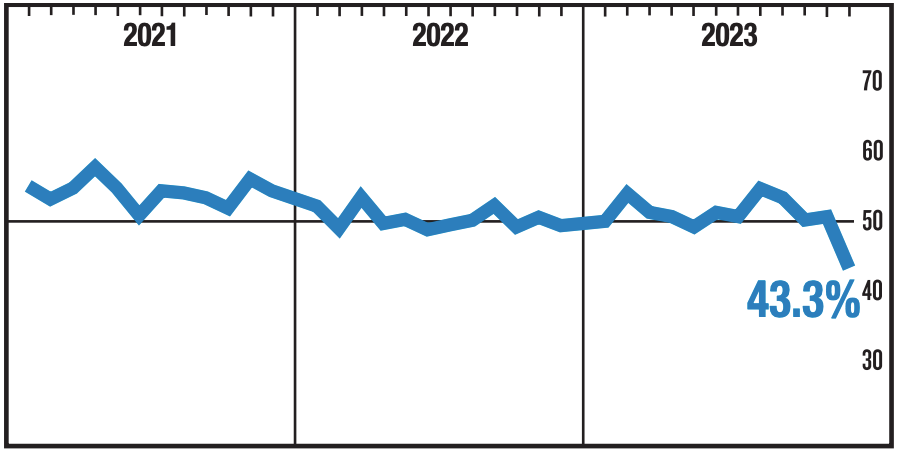

Manufacturing survey signal contraction. S&P Global’s December Manufacturing PMI signaled deterioration in the sector. From the report: “Output fell at the fastest rate for six months as the recent order book decline intensified. Manufacturing will therefore likely have acted as a drag on the economy in the fourth quarter.”


The ISM’s December Manufacturing PMI improved slightly for the month, but still signaled contraction for the 14th consecutive month.


It’s worth remembering that soft data like the PMI surveys don’t necessarily reflect what’s actually going on in the economy.
Construction spending rises. Construction spending rose 0.4% to an annual rate of $2.05 trillion in November.


Business investment picks up. Orders for nondefense capital goods excluding aircraft — a.k.a. core capex or business investment — rose 0.8% to a record $73.97 billion in November.


Near-term GDP growth estimates improve. The Atlanta Fed’s GDPNow model sees real GDP growth climbing at a 2.5% rate in Q4.
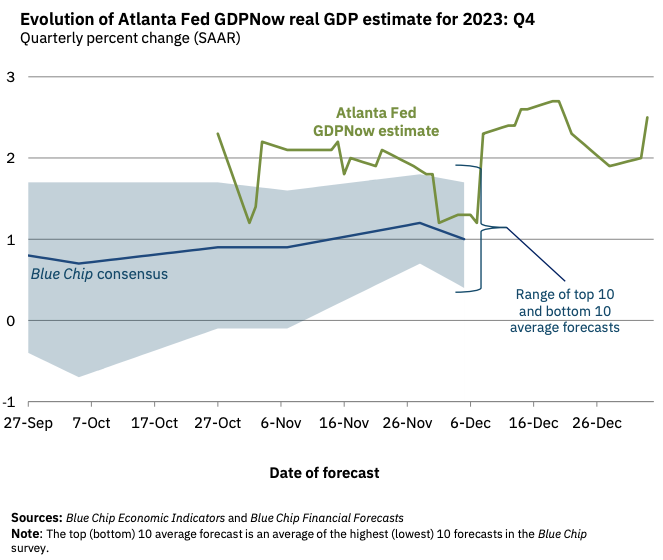

Putting it all together
We continue to get evidence that we are experiencing a bullish “Goldilocks” soft landing scenario where inflation cools to manageable levels without the economy having to sink into recession.
This comes as the Federal Reserve continues to employ very tight monetary policy in its ongoing effort to bring inflation down. While it’s true that the Fed has taken a less hawkish tone in 2023 than in 2022, and that most economists agree that the final interest rate hike of the cycle has either already happened or is near, inflation still has to cool more and stay cool for a little while before the central bank is comfortable with price stability.
So we should expect the central bank to keep monetary policy tight, which means we should be prepared for tight financial conditions (e.g., higher interest rates, tighter lending standards, and lower stock valuations) to linger. All this means monetary policy will be unfriendly to markets for the time being, and the risk the economy slips into a recession will be relatively elevated.
At the same time, we also know that stocks are discounting mechanisms — meaning that prices will have bottomed before the Fed signals a major dovish turn in monetary policy.
Also, it’s important to remember that while recession risks may be elevated, consumers are coming from a very strong financial position. Unemployed people are getting jobs, and those with jobs are getting raises.
Similarly, business finances are healthy as many corporations locked in low interest rates on their debt in recent years. Even as the threat of higher debt servicing costs looms, elevated profit margins give corporations room to absorb higher costs.
At this point, any downturn is unlikely to turn into economic calamity given that the financial health of consumers and businesses remains very strong.
And as always, long-term investors should remember that recessions and bear markets are just part of the deal when you enter the stock market with the aim of generating long-term returns. While markets have had a pretty rough couple of years, the long-run outlook for stocks remains positive.
A version of this article was published on TKer.co.



